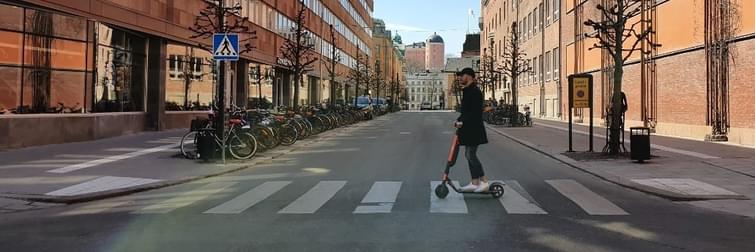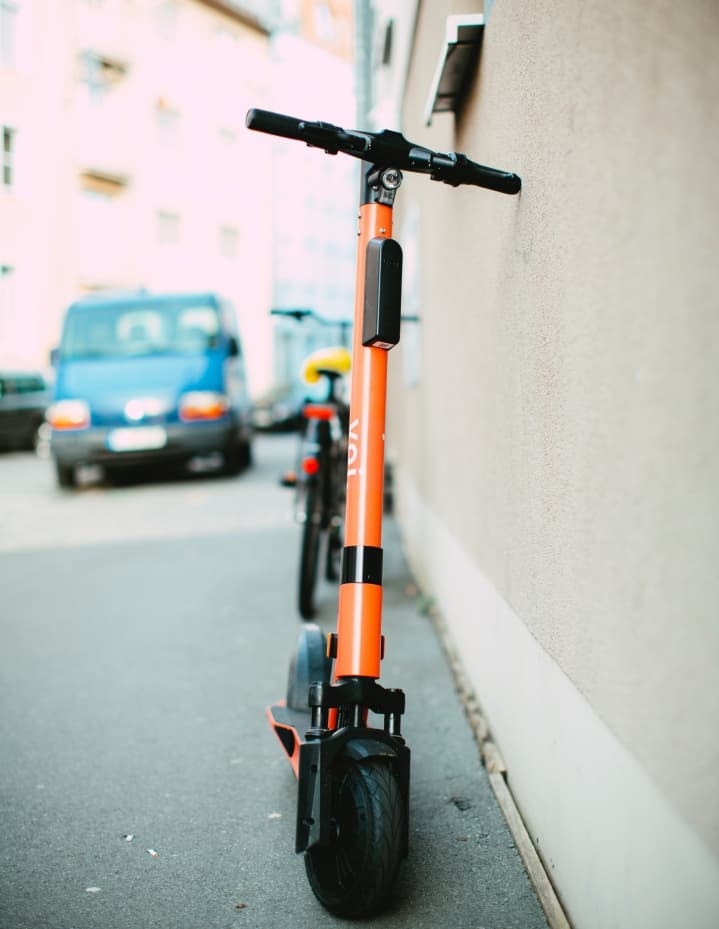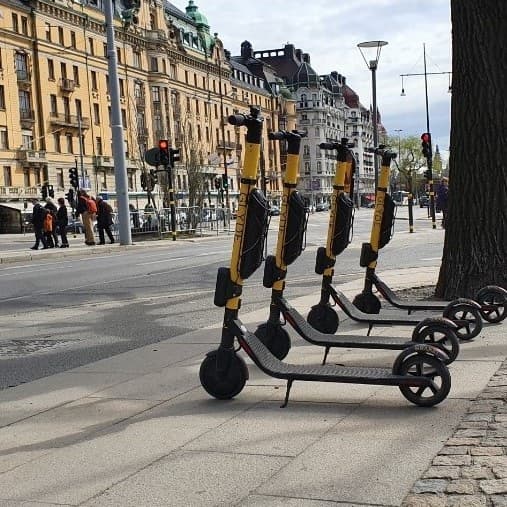
blog: E-scooters mustn’t become a scapegoat for other issues with our transport system
Thursday 2nd July 2020
The Department for Transport's (DfT) announcement to allow trials of rental e-scooters to commence from Saturday 4th July is one that I very much welcome.
Originally scheduled to commence in 2021 in selected areas only, e-scooter trials have been fast-tracked to coincide with the government’s latest phase of lockdown easing and have been opened up to all transport authorities in England, Scotland and Wales.
As more people return to work and more leisure activity becomes permissible, government is keen to prevent an ‘en masse’ return to car use that could overburden our towns and cities, and give people viable alternatives to public transport at a time where public transport use is being actively discouraged. In doing so, government is hoping that e-scooters can complement the significantly increased walking and cycling activity observed since lockdown as part of a great ‘green transport restart’.
While new to the UK, e-scooters have become part of the furniture of many other world cities since the first schemes launched in 2017, and like any new disruptive mode of transport, there have been challenges bedding them in.
Why are e-scooters so popular?
E-scooters are, first and foremost, fun and easy to ride. This gives them immense user utility and challenges the traditional economic predisposition that transport is a wholly derived demand. For example, very few people ride a bus or a train for pleasure. However, e-scooters, have a broader recreational appeal that can contribute to health and wellbeing.
E-scooters also sit very neatly between walking and cycling within the modal mix. The average trip length for a rental e-scooter is around 1.8km, compared to 0.9km for the average walking trip and 3.4km for a cycled journey (Civity, 2019). It is not through chance that the average e-scooter trip length falls almost exactly halfway between that of walking and cycling.
The challenges of e-scooters
E-scooter providers have been outspoken in their frustration of the UK government’s lack of movement on legalisation to date. However, I would argue that DfT’s approach to adopt a watching brief of the experiences of other countries has been a responsible one. Indeed, the externalities that e-scooters generate are not insignificant, some are rather complex and none should be considered in isolation of the rest of the transport system. I’ve discussed three of the most pertinent challenges below.
1. Safety
Ensuring the safety of users and non-users alike is the number one priority of any transport provider whether they sit in the public or the private sector. While e-scooter operators attest that their vehicles are safe and are continually being upgraded to include new safety-oriented features, the reality is that the evidence on the safety implications of e-scooters just isn’t mature enough to make any firm assertions. Moreover, even if it was, it would be inappropriate to assume that this evidence would be directly transferable to a UK context with a very different transport environment; whether that evidence be favourable or less favourable. Safety must therefore be a key focus of the DfT’s national e-scooter trial evaluation programme.
The expectation is that they will be ridden in cycle lanes and otherwise on roads. The unfortunate reality in the UK is that cycle lanes are not abundant enough, lack a network approach to planning in many cities, and largely fall below the best practice design standards presented in the Netherlands and elsewhere.
This will inevitably marginalise many e-scooter users to the footway in the same way that cyclists are today, which does risk creating increasingly hostile environments for pedestrians.
Of particular concern is the impact that this will have on older people and people with certain types of disabilities who are either at greater risk of injury and/or who feel more vulnerable and exposed. All of this absolutely has to be tested.

However, my view is that the single greatest risk factor to the safe operation of e-scooters is the car-centred way in which we have designed our towns and cities to date. And this could prove to be the decisive factor in the success of trials.
It is difficult to conclude that a vehicle that weighs about as much as the hand luggage you take on a flight, with a maximum speed that is broadly equivalent to that required to run a 4-minute mile, poses a significant safety risk where it is used responsibly and is given the recourse to be used responsibly.
2. Street clutter
The challenges of free-floating, dockless transport services are well known to UK authorities with experience of dockless bike rental schemes. And there is no greater issue in respect of the free-floating model than the clutter generated by irresponsibly parked vehicles; in this case electric scooters.
Clutter blocks footways, creates a trip hazard, is unsightly and can be extremely problematic for wheelchair users and people who are blind or visually-impaired in their efforts to navigate the street. The negative effects of clutter is the primary reason why many cities are now moving to regulate the parking of e-scooters, including Paris.
Through my discussions with industry, I have found that regulating parking is generally welcomed by operators, particularly in dense urban environments, where it is designed well. Parking regulation can generate efficiencies in respect of operating and maintenance costs, while nervousness usually relates to issues of network density and an overly-fastidious approach to enforcement. These are crucial issues for operators, and where a transport authority fails to get them right, a scheme can be killed entirely.
It is positive to see that the DfT is requiring all authorities pursuing trials to demonstrate that the impacts of e-scooters on people with disabilities have been considered and addressed. For me, this means parking regulation is a must.
3. Abstraction
The question of where e-scooter trips are generated from is one that I get asked a lot. The truth is that e-scooters are probably taking a little bit of mode share from everywhere, but they also have the potential to generate new trips which provides fresh economic impetus.
Much of the concern expressed by authorities on the issue of abstraction relates to whether or not walking and cycling levels would be undermined. This is a serious issue given the significant health benefits of these modes, which local authorities have been working very hard to promote in recent years.
We will ultimately have to wait for the trial evaluation to run its course, but I think there is good reason to suggest that these modes would not experience significant reductions in share.

There is undoubtedly some overlap between e-scooters and longer walking trips, and e-scooters and shorter cycle trips, but there is also a very significant potential for e-scooters to replace some short car trips which builds a positive case in terms of activity as well as congestion and air quality.
Of course, in many parts of the UK, the private car is the dominant mode of travel and if e-scooters are shown to facilitate a reduction in car use, I have little doubt that they will be viewed positively.
I also think that it’s difficult for e-scooters to replace much of what people value from walking and cycling. Walking is particularly convenient, is completely free of charge and provides an opportunity for people to switch off and unwind. Meanwhile, cyclists often value the speed, ease of travel, and the level of exercise that the mode enables them to readily build into their daily lives. This is particularly true of regular cyclists.
My hope for trials
In order to address the transport, climate and local air quality issues that we have in the UK today, we need to be able to provide individuals with the fullest possible range of sustainable travel alternatives to the private car. For this reason, and for the additionality that I believe e-scooters provide, I really want to see the trials succeed.
Through the conversations I’ve been having with authorities, it’s great to see that there’s a diverse range of trial approaches and use cases being developed that will enable different deployments and different types of regulation to be assessed and evaluated. However, I do hope that transport authorities won’t be shy to bring trials forward at scale because only then can we truly understand the full range impacts of e-scooters, positive and negative, and to prevent the resurgence of car use at this crucial time as we transition out of lockdown towards a ‘new normal’.
My main concern is that the poor quality of infrastructure that we have in the UK, particularly cycle lanes, will prove problematic for scaling operations up further and I really hope that e-scooters do not become victimised by inadequacies that exist elsewhere. There will undoubtedly be teething problems, as there always are, but I implore everybody to view these trials as a ‘moment-in-time’ opportunity to reimagine the relationship that we have with transport in the UK.
About ITP
ITP is a specialist sustainable transport planning and research consultancy operating in the UK and internationally since 1998. We are experienced in developing active travel strategies and business cases for central and local government, working to promote the needs of older and disabled people in transport policy and strategy development, and have contributed towards the design of bike share schemes in three major UK cities. For more information on the services ITP can provide to support the design, delivery and evaluation of e-scooter trials in your area, please get in touch with Thomas Fleming (fleming@itpworld.net).
